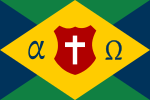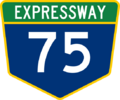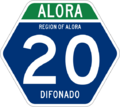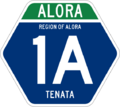Alora

|
Republic Of Alora Republikā dā Alōrā (Aloran) Capital: Mopaso City
Population: 39,585,851 (2021) Motto: "Quem dedit nobis libertas" (He has given us liberty) Anthem: O True Immortal |
Loading map... |
Alora, (English pronunciation: [ɑːlo:rə]) officially the Republic of Alora, is a federal constitutional republic in southern part of the great continent of Uletha. It consists of 23 states that are located within 3 administrative regions. The countries land area is just over 531,864 square miles (1.377 million square kilometers). The country shares its borders with Gobrassanya to the southeast on the Gobras Peninsula, UL06d in the northeast, Arsha, UL05e, and UL07d to the north and Epeltasúna and the former Celesto Republic to the west. With a population of more than 39 million people. The national capital is Mopaso City, and the largest city in Alora is Staughley which is located along the southern coast in the state of Teneco.
Alora is a highly developed country, with a strong economy and high GDP. It is a charter member of the Assembly of Nations. It also is a member of the Gobras Peninsula Free Trade Agreement, the Ulethan Alliance for Culture (UAC), the Southern Uletha Economic Cooperation Council among other international organizations.
Alora Considered a melting pot of indigenous and imigrant cultures and ethnicities, some of this is due to colonization of the countries of Alora and Takora early on in its history. The indigenous peoples of Alora are the native Aloran Peoples, the native peoples of Takora and the Gobrasi. Today native populations comprise 27% of the total population of Alora and Takora. Alora ranks high in international measures of economic freedom, standard of living, education, and human rights; and has relatively low levels of perceived corruption due to safeguards and laws passed to curtail corruption. Government structure in Alora is built on transparency and accesibility of information which is undergirded by the Aloran Federal Transparency Act of 1979.
Etymology
History
Government and politics
Administrative Divisions
 | |
|---|---|
| Administrative divisions of Alora | |
| First-level | 3 regions |
| Second-level | 23 states |
| Third-level | TBD counties |
| Fourth-level | cities, towns, villages |
 See also: Administrative divisions of Alora
See also: Administrative divisions of Alora
Alora is organized into 4 levels administrative subdivisions. There are the 3 administrative regions at the highest level. The country is further divided into 23 states (or estados in castellánese speaking areas in western Takora). 11 of these states are located within the Alora region, 4 states lie within the region of Escaskia, and 9 states that lie within the region of Takora (also known as the Territory of Takora). States are further subdivided into either counties (or condados in castellánese speaking areas in western Takora). The smallest incorporated divisions are cities, towns, and villages. which may be part of larger metropolitan areas or townships. Unincorporated divisions include communities and localities.
| Regional Flag | Region | Regional Seat |
|---|---|---|
| Region of Alora | Mopaso City | |
| Region of Eskaskia | Athalan | |
| Region of Takora | Takorado |
Regions
Regional levels of administration are managed at the national level. The regions within Alora do not have their own regional governments, constitutions, elected officials or legislative bodies and thusly are represented by the elected senators and representatives of the states which lie in each region. Regional administrators and justices are appointed by the central government at the direction of the executive branch and must be confirmed by the legislature. Regional governmental control is centralized in the capitol of Alora in Mopaso City but is also divided among administrative seats in each region which conduct the functions of regional administration in each region.
Territorial Possession
- The Territory of Takora - was a special administrative region that also has the distinction of being a territory. The Territory of Takora was created when Takora was adopted or annexed into the Union by ratification of the Aloran and Takoran Unification Treaty in 1974. This treaty placed Takora as a territorial possession of the nation of Alora and gave Takora its own limited governance under the authority of the Aloran Constitution and Legislature of Alora. Its Capital, Takorado Served as the territorial capital until it officially became part of the Republic or Alora in 1998 and was designated as a region. Takora's status as territory is now symbolic. Takorado is the regional seat of Takora.
Political Climate
Aloran politics fall within the middle--right to center-right spectrum when it comes to political opinion and thought. By and large the country is considered to be a conservative country which is reflected in its policy, laws and penal code. The majority of Alorans belong to the Constitution and Liberty Party the mainline conservative party, and the Freedom Party which leans further to the right and is considered a fundamentalist party by some on the right and many on the left. Other political affiliations include the Progressive Party a center-left to middle-left party and the more liberal Neo-Green Party an environmentalist and revolutionist group which has been known for its activism and for acts of violence perpetrated by its more fundamentalist fringe members. Several minority parties also exist such as the [Centrist Party] a libertarian party that leans conservative on most fiscal and social issues but desires to be liberated from oppressive government regulation and prohibition of use of controlled herbal substances. The Anarchist Party is a party that opposes colonial government and desires the destruction of all government systems. and finally there are the independents that do not choose a party affiliation. Independents are not officially organized into an official party.
Political Affiliations
| Party Name | Abbrev | Political Spectrum | Total % of registered Aloran voters |
|---|---|---|---|
| Constitution and Liberty Party | (C) | center-right to middle-right | 45% |
| Progressive Party | (P) | center-left to middle-left | 35% |
| Freedom Party | (F) | middle-right to far-right | 10% |
| Neo-Green Party | (NG) | middle-left to far-left | 4% |
| Centrist Party | (CENT) | middle line | 4% |
| Anarchist Party | (ANA) | extreme-left | <1% |
| Independents (non-affiliated) | n/a | mostly middle line | 2% |
Constitution and Government
The Aloran Constitution was ratified on September, 1 1801 The government is a representative republican form of democracy, <meaning people vote for representatives that bring the needs of their constituencies (the people) to the house and senate to be discussed. This is where proposed law and policy are made. These laws are then sent to the president to be signed or vetoed. The house and senate both have the power to overturn legislation based on a super-majority (2/3) vote of both houses in a combined vote. Constitutional Amendments are also ratified by a super-majority vote of both houses and the respective two-thirds of the state and territorial governments assemblies and senates. Once ratified constitutional amendments become law and can only be repealed by constitutional amendment process.
The president has the authority to enact temporary executive orders that expire at the end of his current term or for 2 years following his term if the president has less than 2 years left to serve. This power is given to address issues that are pressing for national security or stability however must be ratified by congressional super-majority in order to become the permanent law. Presidents are limited to a total of 3 terms in office and are elected once every 3 years by electoral college that is based on the majority vote of each state. The state or territory sends the appropriate number of electors to cast votes for each candidate based on the popular vote.
Each state has 2 senators and several congressmen based on the population and size of the territory of the state. This is calculated total population and weighted by 10% based on total square miles of the state. Territories also have representatives, but no senators.
International Relations
Geography
Climate
Economy
 See also: Economy of Alora
See also: Economy of Alora
Currency
Main Article: Aloran Talent
The currency of Alora is the Aloran Talent (₮) (ISO currency code: ALT). The Talent is divided into 100 Sheks. Coins minted include 1-, 2-, 5-, 10-, 20- and 50- Shek coins and half-, and 1- Talent coins. Banknotes include 1-, 2-, 5-, 10-, 20-, 50-, 100-, and 200- Talent banknotes. Valuation of 1.985 USD. 500-, 1000-, and 2000- banknotes were also in circulation but were rare. The advent of electronic bank transfers, debit/credit cards, and Wire transfers available for large monetary transfers has made the banknotes less needed. A 3 talent note was also in use until 2001 when it was also retired, there are still many of these notes in circulation. Older archaic denominations include a 1/3 Talent coin which is no longer in use but is highly collectible.
Cash Prices are expressed in decimals to two places (₮1.50) Some representatives in the Alora Legislature proposed a cashless system in 1985 but that proposal died in closed legislative sessions due to extreme opposition to the plan. There has been rumblings that some legislators are working in secret again to revive the plan under a different name and present it to the legislature again in 2020. Opposition is again expected to be strong and it is unsure if Alorans will ever be willing to give up their Physical currency.
Ebux is another form of currency circulated in Alora and it is a completely electronic bit based currency run by a private coalition of Aloran businesses to provide an alternate means of purchasing and currency for people in the southern Uletha. Ebux wallets are available on the internet and can be easily loaded or spent at participating merchants by scanning a target code.
Demographics
| Demographics of Alora | |||||||||||||||||||||||||||||||||||||||||
|---|---|---|---|---|---|---|---|---|---|---|---|---|---|---|---|---|---|---|---|---|---|---|---|---|---|---|---|---|---|---|---|---|---|---|---|---|---|---|---|---|---|
| Demonym | Aloran | ||||||||||||||||||||||||||||||||||||||||
| Official languages | Ingerish, Gobrassian | ||||||||||||||||||||||||||||||||||||||||
| Recognized minority languages | Aloran, Takoran, Gaerman, Castellánese | ||||||||||||||||||||||||||||||||||||||||
Ethnicities | |||||||||||||||||||||||||||||||||||||||||
| |||||||||||||||||||||||||||||||||||||||||
Religion | |||||||||||||||||||||||||||||||||||||||||
| |||||||||||||||||||||||||||||||||||||||||
| Literacy | |||||||||||||||||||||||||||||||||||||||||
| Life expectancy | |||||||||||||||||||||||||||||||||||||||||
Language
Ethnicity
Religion
The official religion of Alora is Known as The Way or the Christic Movement. Followers of this faith are known as "Followers". While the adoption of The Christic Movement as the official religion of Alora was established by the constitution it is only ceremonial in nature and the government offers no monetarily support nor does it collect any royalties, taxes, or tributes from churches or any other religious organization. while the government does not recognize other religious belief systems there is a policy that supports freedom of religion and they are generally tolerated with a very few exceptions (such as religious groups that would cause harm to life and property). Prior to this the "Christic Movement" had been made the official religion of the country but there were issues regarding its establishment as the official religion of the government and the government sought control of churches and church activities and used it as a source of generating revenue for the government during the years of monarchical reign (1599 to 1800) and the confiscation of church wealth during the 300 years of feudal government that proceeded that. These periods are known by Christic Followers as the "History of Wrongs" and lead to the current constitutional protections that exist for the Christic Movement and by default all other religions as well. Even though the government has officially recognized the Christic Movement as its official religion it has no power of enforcement or taxation upon churches or religious organizations.
Infrastructure
Transportation
 See also: Transportation in Alora
See also: Transportation in Alora
Highways

|

|

|
| Takoran Expressway marker | Class A Trunk Highway | Class C Trunk Highway |
- Aloran Expressway System
Alora has a system of highways and expressways that provide transportation for motor vehicles and commercial freight traffic. The most advanced system is the Aloran Expressway System which consists of a fully access-controlled grade-separated freeway system, most of which is toll-free with only limited toll crossings. Expressways are identified with the prefix "E-' before the route number (ie. E-45 or E-99). Sections of the Aloran Expressway System that have not been updated to freeway status are listed as trunk roads and identified by the prefix "A-" or "C-"before the route number such as A-5 or C-8 (depending on the stage of development) which when upgraded will eventually become E-5 once it is converted to a full freeway. Highways are numbered from E-10 in the north to E-90 in the south and E-15 in the west to E-95 in the east. Odd numbered highways travel north and south and even highways travel east and west. Highways E-1 through E-9 are diagonal highways that connect major cities or follow special important routes.
For more information see Aloran Expressway System for more info

|

|

|
| Primary NHS marker | Alternate NHS marker | State Highway |
- National and State Highways
Other highways in Alora are classified either as National or state Highways. National Highways are numbered differently from the expressway system and odd numbered roads travel east-west and even routes travel north-south to avoid confusion with the expressway system. State Highways are identified by their own markers and have a two letter prefix that corresponds to their state abbreviation. State routes are marked with a unique route sign depending upon the state. A generic state marker exists.
For more information on State and National Highways see Highways in Alora for more info
